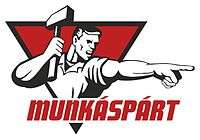Hungarian Workers' Party
Hungarian Workers' Party | |
|---|---|
 | |
| Leader | Gyula Thürmer |
| Founded | 17 December 1989 |
| Headquarters | H-1082 Budapest, VIII. Baross u. 61. |
| Newspaper | A Szabadság |
| Youth wing | Baloldali Front |
| Ideology |
Communism Marxism–Leninism Euroscepticism |
| Political position | Far-left[1] |
| European affiliation | Initiative of Communist and Workers' Parties |
| International affiliation | International Meeting of Communist and Workers' Parties |
| European Parliament group | None |
| Colours | Red |
| Website | |
|
www | |
The Hungarian Workers' Party (Hungarian: Magyar Munkáspárt) is a communist party in Hungary led by Gyula Thürmer. Established after the fall of the communist Hungarian People's Republic, the party has yet to win a seat in the Hungarian parliament. Until May 2009 it was a member of the Party of the European Left.
History
The party was established as the Hungarian Socialist Workers' Party on 17 December 1989 as a successor party of the Hungarian Socialist Workers' Party (MSZMP) by a small group of old MSZMP members who opposed its transformation into the Hungarian Socialist Party (MSZP). In the 1990 elections it received around 3% of the national vote, the largest share for a party that failed to win a seat.[2][3]
In 1993 the party adopted the name Workers' Party, and in the same year a group of hard-liners broke away to form another Hungarian Socialist Workers' Party. The 1994 elections saw the party win a similar share of the vote, again emerging as the largest party without a seat. Despite increasing its vote share to around 4% in the 1998 elections, the party again remained seatless. The 2002 elections saw the party's vote share fall to around 2%, and for the first time since 1990, not the largest party without parliamentary representation.[2][3]
On 12 November 2005 it became the Hungarian Communist Workers' Party when a split led to the formation of the Workers' Party of Hungary 2006 led by János Fratanolo. In the 2006 elections the party received less than 0.5% of the national vote, whilst the 2010 elections saw its vote share fall to just 0.1%. On 11 May 2013 the party was renamed again, this time becoming the Hungarian Workers' Party due to a law passed the previous year banning the public use of names associated with "authoritarian regimes of the 20th century."[4] In the 2014 parliamentary election, the party received 0.56% of the votes, again the largest party without parliamentary seats.
In the question of the Hungarian migrant quota referendum, 2016, the party called for a "no" vote, expressing opposition to what they perceive as an "EU aggression" against Hungary.
Ideology
The party opposed Hungary joining NATO. In 1996 the party organised a countrywide collection of signatures for a referendum on NATO membership. This HCWP-led referendum drive failed, although another referendum on NATO membership was held in 1997, which resulted in a vote in favour. The party continues to oppose the country's participation in NATO and other military organisations. It campaigns to have all Hungarian forces returned from abroad and to reduce the military budget. The party opposed Hungary's participation in the "democratisation" program that has previously targeted the governments of Serbia and Belarus and strongly opposed NATO campaigns in Yugoslavia against Slobodan Milošević and the 2003 invasion of Iraq.
Other foreign policies are in favour of
- a peaceful and just settlement of the Middle East crisis, in favour of the "progressive" Arab countries.
- a foreign policy based upon "good relations" with all parts of the world.
- qualified support of Hungary's entry to the European Union. It has emphasised its view that the government should focus more upon those who lose out due to liberalised trade, doing all that it possibly can.
Election results
For the Hungarian Parliament:
| Elections | Number of votes (1st round) |
Percentage of votes (1st round) |
Number of votes (2nd round) |
Percentage of votes (2nd round) |
Number of seats | Percentage of seats | Role played in Parliament |
|---|---|---|---|---|---|---|---|
| 1990 | 180,889 | 3,68% | 8 640 | 0,25% | — | — | extra-parliamentary |
| 1994 | 172,117 | 3,19% | 6 268 | 0,15% | — | — | extra-parliamentary |
| 1998 | 183,064 | 4,08% | 10 861 | 2,25% | — | — | extra-parliamentary |
| 2002 | 121,503 | 2,16% | — | — | — | — | extra-parliamentary |
| 2006 | 21,955 | 0,41% | — | — | — | — | extra-parliamentary |
| 2010 | 5,606 | 0,11% | — | — | — | — | extra-parliamentary |
| 2014 | 27,670 | 0,58% | N/A | N/A | — | — | extra-parliamentary |
For the European Parliament:
| Elections | Number of votes | Percentage of votes | Number of seats | Group in the European Parliament | Subgroup in the European Parliament |
|---|---|---|---|---|---|
| 2004 | 56,221 | 1,83% | 0 | — | — |
| 2009 | 27,829 | 0,96% | 0 | — | — |
References
- ↑ Jeffries, Ian (2002), Eastern Europe at the Turn of the Twenty-First Century: A guide to the economies in transition, Routledge, p. 212
- 1 2 Nohlen, D & Stöver, P (2010) Elections in Europe: A data handbook, p924 ISBN 978-3-8329-5609-7
- 1 2 Nohlen & Stöver, p932
- ↑ "Hungarian CWP, New name of the Hungarian CWP". Solidnet. 14 May 2013. Retrieved May 18, 2013.
External links
- Party website (Hungarian)
- A szabadság Weekly newspaper of the party
- Baloldali Front Party's youth organisation